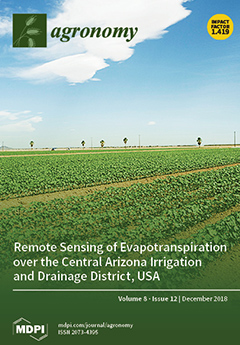The present study assesses the response of hybrid rice (variety Arize 6444) to potassium (K) application during rainy (wet) seasons of 2016 and 2017 in coastal saline soils of West Bengal, India. The study was conducted at the Regional Research Farm, Bidhan Chandra Krishi Viswavidyalaya, Kakdwip, West Bengal. The soil is clayeywith acidic pH (5.91), saline (Electrical conductivity/EC 1.53 dS m
−1) and of high K fertility (366 kg ha
−1). The experimental plots were laid out in a randomized complete block design with five (5) K treatments (0, 30, 60, 90, and 120 kg K
2O ha
−1) with four replications. Plant height, dry matter (DM) in different plant parts, number of tillers, and grain yield were measured in each treatment for the determination of optimum K dose. The study revealed that the stem, leaf, and grain dry matter production at 60 days after transplanting (DAT) and harvest were significantly (
p ≤ 0.05) higher at 90 kg K
2O ha
−1 application. The number of tillers hill
−1 was also higher (
p ≤ 0.05) in plants fertilized with 90 kg K
2O ha
−1 over K omission. At harvest, grain K concentration improved (
p ≤ 0.05) with K fertilization at 90 kg K
2O ha
−1, 116% more than the zero-K. Omission of K application from the best treatment (90 kg K
2O ha
−1) reduced grain yield by 3.5 t ha
−1 even though the available K content was high. Potassium uptake restriction due to higher Mg content in the soil may have caused reduced uptake of K leading to yield losses. The present study also showed higher profits with 90 kg K
2O ha
−1 with higher net returns (US$ 452 ha
−1) and benefit:cost ratio (1.75) over other treatments from hybrid rice (var. Arize 6444). From the regression equation, the economic optimum level of K (K
opt) was derived as 101.5 kg K
2O ha
−1 that could improve productivity of hybrid rice during the wet season in coastal saline soils of West Bengal.
Full article





